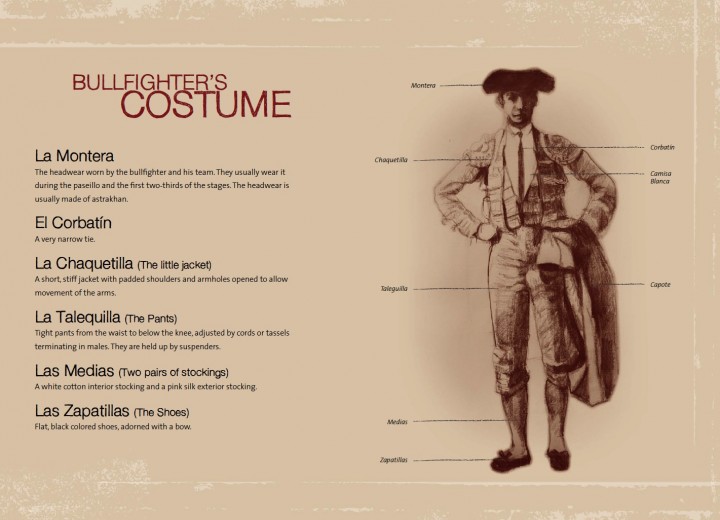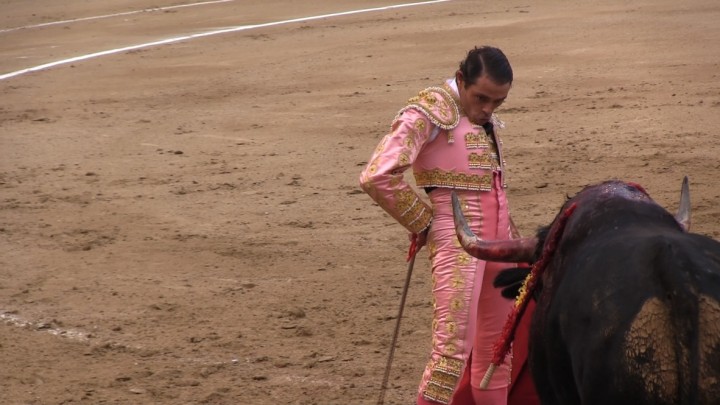Archivo de la categoría: Sin categoría
The Stage Of Banderillas. Bullfighting Step By Step
The main objective of the Stage of “Banderillas” is to revive the bull without reducing its strength in order to prepare it for the next stage: The Stage of Muleta (Suerte de Muleta).
Three bull ghters’ assistants or sometimes the bull ghter him or herself jab the bull’s back with three pairs of “Banderillas”. The bull feels a sharp pain when the “Banderillas” have pierced its back.
Bullfighting With The Red Cape. Bullfighting Step By Step
The Suerte de muleta is fundamental to determine the triumph or failure of the bull ghter. It is in this phase that the bull ghter, facing the bull alone, must demonstrate his close and personal idea of
what it means to be a bull ghter. At the sound of the bugles and the drums, the bull ghter receives the red cape and the sword from the swordsman’s assistant.
If it is the bull ghter’s rst bull, he addresses the presidency to request the appropriate permission and after paying homage, or perhaps not, to the death of the animal, he goes to the bull.
The bull will be taken by the matador’s support team to the place selected by the bull ghter. From there, if the animal responds, he takes the bull into the middle of the ring, where a sense of solitude is even more pronounced.
“La Faena” is a collection of a series of connected steps the bull ghter makes, remaining still while the bull circles him. The bull ghter ́s intent, through the power of his cape and not because of the bull ́s natural erceness, is to make the animal charge. The most valued elements in this stage are the excitement of the bull ghter ́s execution of steps, together with the courage the bull displays to oppose dif culties. This ends with the “Suerte suprema”, and is followed with the killing
of the bull.
Bullfighting With The Cape ( Bullfighting Step By Step)
Bullfighting Step By step
Bullfighting with the CAPE “Suerte de Capa o Capote”
As bullring’s staff show a banner with the name and weight of the rst bull on it, one of the “Alguacilillos” gives the key to the bullpens to the “Chulo de Toriles” (the person in charge of opening the door from which the bull comes out into the ring). Once the “Areneros” have cleaned the ring and everything is in order, the president taking out the white kerchief, orders the rst bull to be released.
After a short sound of the bugles, the door of the bullpen is opened and the bull goes out into the arena.
The members of the matador’s team and the matador face the bull with the cape. In the first two stages of the bull ght, the cape is used to “situar en suerte”, in other words, to take the bull to an ideal spot to be jabbed by the Picador and to be stabbed in the neck with the “Banderillas”. But the bull ghter also uses the cape artistically. There is a wide range of ways of using the cape
www.bullfightticketsmadrid.com Season 2019
El Paseíllo ( Bullfighting Step By Step)
Once the ring has been cleaned the opening procession starts.
Preceded by the “Alguacilillos”, the bullfighters
and their teams go around the arena to the royal box
to greet the President.
The three bullfighters do so in order of seniority.
Seen from the front, the most veteran is to the right,
the most novice is in the middle and to the left is the
one with intermediate experience.
The “Banderilleros” (the ones who jab the bull
with the “banderillas”) are situated also from
right to left, according to their seniority and they
march behind the swordsman.
Following them, two by two, the Picadores and
finally, the Mozos de Caballos (the horseman’s
assistants), the “Areneros” (the men in charge
of the sand in the bullring), are followed by the
mules and the “Mulilleros” (the men in charge
Bullfighting Stept By Stept: The Clearing
Carteles de la Feria de La Macarena
Ayer, la empresa que gestiona la Plaza de Toros de Medellín hizo públicos los carteles de la edición 28 de la Feria de La Macarena:
– Sábado, 26 de enero: Corrida mixta. El rejoneador Andrés Rozo, y los novilleros Gitanillo de América y otro por designar (Toros y novillos deRincón Santo)
– Viernes, 1 de febrero: David Martínez, Joaquín Galdós y Jesús Enrique Colombo (El Manzanal).
– Sábado, 2 de febrero: El Cid, David Mora y Juan de Castilla (Miguel Gutiérrez).
– Viernes, 8 de febrero: Curro Díaz, Emilio de Justo y Luis Miguel Castrillón (Santa Bárbara).
– Sábado, 9 de febrero: Enrique Ponce, Luis Bolívar y Roca Rey (Juan Bernardo Caicedo).
Las corridas los viernes serán a las 7:30 de la noche y los sábados a las 4:00 de la tarde
Los Toros de Victorino Martín vuelen a Madrid el 14 de Abril
Tal y como ha venido sucediendo en las últimas temporadas, los toros de la ganadería de Victorino Martin volverán a ser protagonistas en la corrida que se celebrará el próximo Domingo de Ramos en la Plaza de Toros de Las Ventas de Madrid. También parecen aseguradas para la ganadería su participación en dos tardes de la próxima Feria de San Isidro.
La Plaza de Toros de Calí
Calí es la tercera ciudad más importante de Colombia. Es una localidad muy atractiva para el turismo, especialmente durante la celebración de su Feria y la Temporada Taurina en Cañaveralejo ten el mes de Diciembre. La plaza de Toros de Cali ha sido escenario de corridas de toros de primera categoría desde hace aproximadamente sesenta años y , actualmente, está considerada como una de las plaza más importantes del mundo. Fue inaugurada en 1957 con una corrida de toros en la que Joselillo de Colombia, Joaquín Bernardó y Gregorio Sanchez lidiaron toros de la ganadería Clara Sierra. El proyecto arquitectónico origina fue dirigido por el ingeniero Guillermo González Zuleta y los arquitectos Jaime Camacho y Julián Guerrero. Mas tarde se incorporaron al proyecto los ingenieros Franciso Villaquiran y Gino Faccio. Está construida con hormigón y cables de postensionamiento. Tiene una capacidad para dieciseitemil espectadores. Está dividio en ocho tendidos provistos de 32 filas cada uno. Tiene 8 puertas superiores y 7 puertas inferiores de acceso . También cuenta con un aparcamiento para unos 750 vehículos. En 1995 fue declarado monumento nacional . Actualmente la empresa Promotoreando, dirigida por Juan Bernardo Caicedo, se encarga de organizar la Feria Taurina.
Los carteles de la Feria de Calí de 2018 son los siguientes:
Diciembre 26 – Novillos de Achury Viejo para Sebastián Hernández, Gitanillo de América y Arturo Gilio
Diciembre 27 – Toros de Juan Bernardo Caicedo para Enrique Ponce, Luis Miguel Castrillón y Roca Rey.
Diciembre 28 – Toros de Guachicono para Ramsés, Emilio de Justo y Ginés Marín.
Diciembre 29 – Festival Señor de los Cristales con novillos-toros de Salento para Enrique Ponce, Antonio Ferrera, Sebastián Castella, Luis Bolívar, El Payo y Jesús Colombo.
Diciembre 30 – Toros de Ernesto Gutiérrez para Antonio Ferrera, Sebastián Castella, y Luis Bolívar.
Diciembre 31– Toros de Mondoñedo para El Payo, Juan de Castilla y Jesús Enrique Colombo.
Los Alguacilillos
 Los Alguacilillos son empleados que han dependido históricamente de las autoridades administrativas, funcionarios que presiden los festejos y que habitualmente son comisarios de policía. En el pasado sustituyeron a los militares en la función de despejar la plaza antes de la salida del primer toro. Pero lo que los alguaciles hacen hoy en la plaza es un simple simulacro o representación del despejo. Los alguaciles también hoy simulan recibir la llave del toril, pues , en realidad, esta llave está de antemano en poder del empleado encargado de abrir las puertas para que salga el toro. Los alguaciles ,en pareja y a lomos de sus caballos, llevan a cabo toda esta representación vestidos según la tradición de la época del reinado de Felipe IV. Su indumentaria está compuesta de una Golilla blanca, un sombrero con penacho con plumas y una capa negra corta o Jubón. Calzan botas de cuero según la tradición del siglo XVIII. Otras funciones que les competen son la transmisión de las órdenes del presidente a los matadores., la entrega de premios o trofeos a los toreros, preceder a las cuadrillas durante el paseíllo. Una vez realizado el simulacro del despejo, saludan al presidente de la corrida destocándose y con una breve inclinación de cabeza. Si bien antiguamente despertaban animadversión entre el público siendo objeto de todo tipo de mofas , actualmente son respetados y forman parte de la ceremonia taurina en todas los cosos.
Los Alguacilillos son empleados que han dependido históricamente de las autoridades administrativas, funcionarios que presiden los festejos y que habitualmente son comisarios de policía. En el pasado sustituyeron a los militares en la función de despejar la plaza antes de la salida del primer toro. Pero lo que los alguaciles hacen hoy en la plaza es un simple simulacro o representación del despejo. Los alguaciles también hoy simulan recibir la llave del toril, pues , en realidad, esta llave está de antemano en poder del empleado encargado de abrir las puertas para que salga el toro. Los alguaciles ,en pareja y a lomos de sus caballos, llevan a cabo toda esta representación vestidos según la tradición de la época del reinado de Felipe IV. Su indumentaria está compuesta de una Golilla blanca, un sombrero con penacho con plumas y una capa negra corta o Jubón. Calzan botas de cuero según la tradición del siglo XVIII. Otras funciones que les competen son la transmisión de las órdenes del presidente a los matadores., la entrega de premios o trofeos a los toreros, preceder a las cuadrillas durante el paseíllo. Una vez realizado el simulacro del despejo, saludan al presidente de la corrida destocándose y con una breve inclinación de cabeza. Si bien antiguamente despertaban animadversión entre el público siendo objeto de todo tipo de mofas , actualmente son respetados y forman parte de la ceremonia taurina en todas los cosos.




